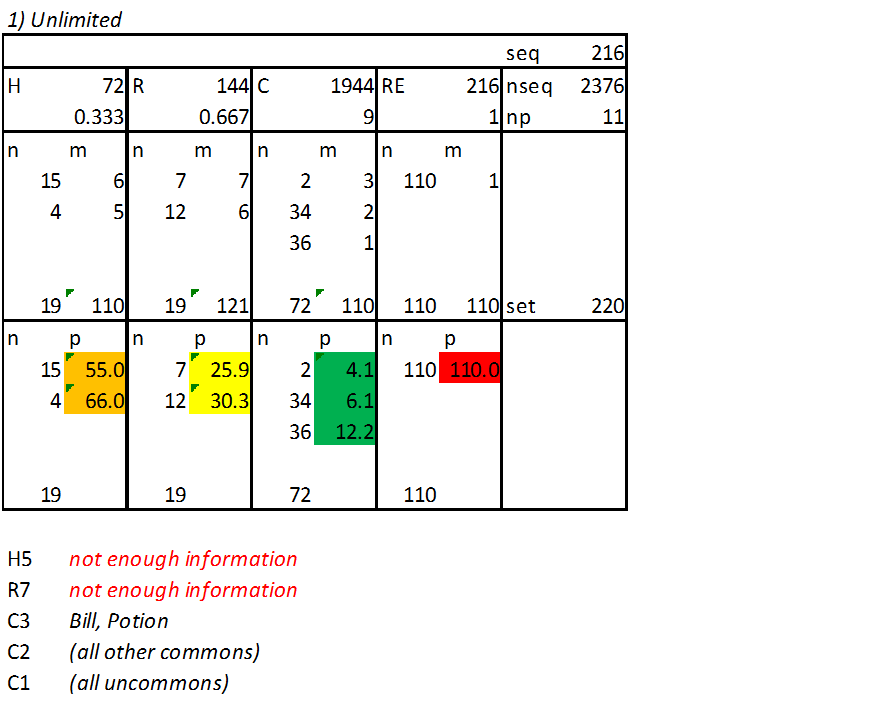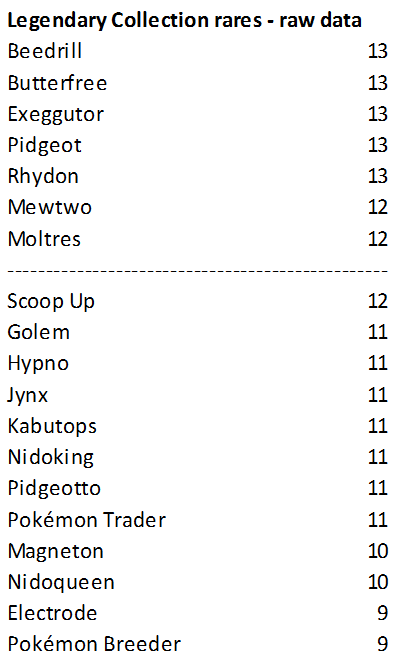Legendary Collection
Legendary Collection is the set that lies at the beginning of this whole project. It was created by WotC with sealed tournaments (booster drafts) in mind, and the contents of packs are obviously not random - packs include Pokémon from evolution families that fit together. This was done by printing the 36 commons and the 36 uncommons on the same sheet, and inserting 9 consecutive cards from the sheet into booster packs. The 110 card sheet is quite easy to reconstruct (it is shown further below), and it was in fact the first sheet I reconstructed. Using a 110 instead of a 121 card sheet enabled having nearly 3 uncommons per pack on average, and making the uncommons twice as rare as the commons, with the exception of two common trainer cards which appear on the sheet 3 times.
Legendary Collection is also the first sheet to feature reverses. They can be seen as a kind of gimmick to get collectors interested in this set containing only reprints, but they have remained a feature of English TCG expansions ever since. I will have more to say on the rarity of reverses in the future, but for Legendary Collection, things appear quite simple. It seems extremely likely all 110 reverses were printed on the same 110 card sheet and have the same rarity, and it is likely the set size of 110 cards was chosen to fit all on one sheet. It may be possible to reconstruct the sheet, since I have observed booster boxes to consist of a run of 36 consecutive packs which has been “cut” and restacked to make the box unmappable, but I have not attempted doing so.
For the rares sheet, I am assuming a sheet size of 121, just like the uncommons sheet for Neo Destiny and the Expedition sheets I reconstructed.
The rarity table looks as follows:
The reverses set a new record for “rarest card so far” with a pull rate of 1:110,0.
The commons/uncommons sheet looks as follows:
† Abra, Kadabra, Abra, Drowzee, Snorlax, Drowzee, Gastly, Haunter, Gastly, Slowpoke, Challenge!, Slowpoke, Dratini, Dark Dragonair, Dratini, Magnemite, The Boss’s Way, Voltorb, Pikachu, Tauros, Magnemite, Pikachu, Seadra, Voltorb, Bill, Magikarp, Potion, Psyduck, Golduck, Psyduck, Seel, Dewgong, Seel, Eevee, Omastar, Pidgey, Squirtle, Dark Wartortle, Squirtle, Tentacool, Tentacruel, Tentacool, Potion, Omanyte, Mysterious Fossil, Mysterious Fossil, Kabuto, Onix, Geodude, Graveler, Geodude, Machop, Machoke, Machop, Mankey, Primeape, Mankey, Onix, Potion Energy, Rhyhorn, Sandshrew, Sandslash, Sandshrew, Rhyhorn, Doduo, Dodrio, Doduo, Pidgey, Growlithe, Potion, Charmander, Charmeleon, Charmander, Ponyta, Rapidash, Ponyta, Vulpix, Energy Retrieval, Vulpix, Eevee, Arcanine, Bill, Rattata, Raticate, Rattata, Bulbasaur, Ivysaur, Bulbasaur, Caterpie, Metapod, Caterpie, Nidoran f, Nidorina, Nidoran f, Bill, Exeggcute, Meowth, Grimer, Exeggcute, Full Heal Energy, Grimer, Nidoran m, Nidorino, Nidoran m, Weedle, Kakuna, Weedle, Spearow, Fearow, Spearow †
The raw data for the holos and rares is shown below, with the dashed line denoting where the transitions from H6 to H5 and from R7 to R6 would occur.
As usual, there is not enough data to say anything for certain, but I would not be surprised if Charizard, Dark Blastoise and Venusaur were among the H5 cards.
Edit 2023/03/27: replaced ambiguous term “reverse holo” with “reverse”; replaced image for rarity table (reverses abbreviated as “RE” instead of “Rev”)


